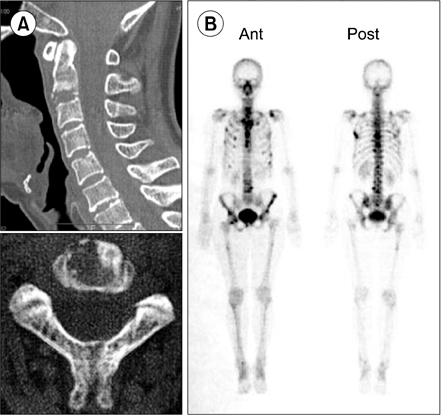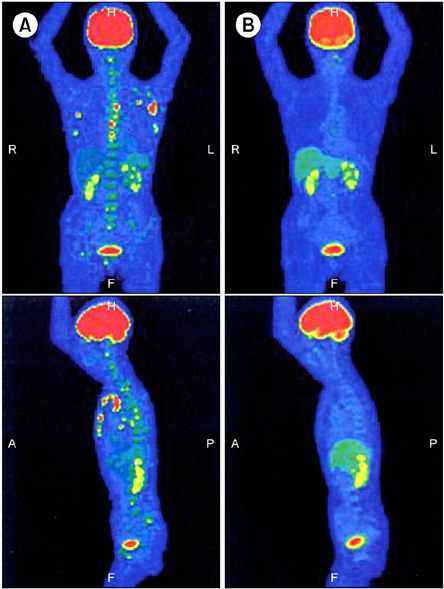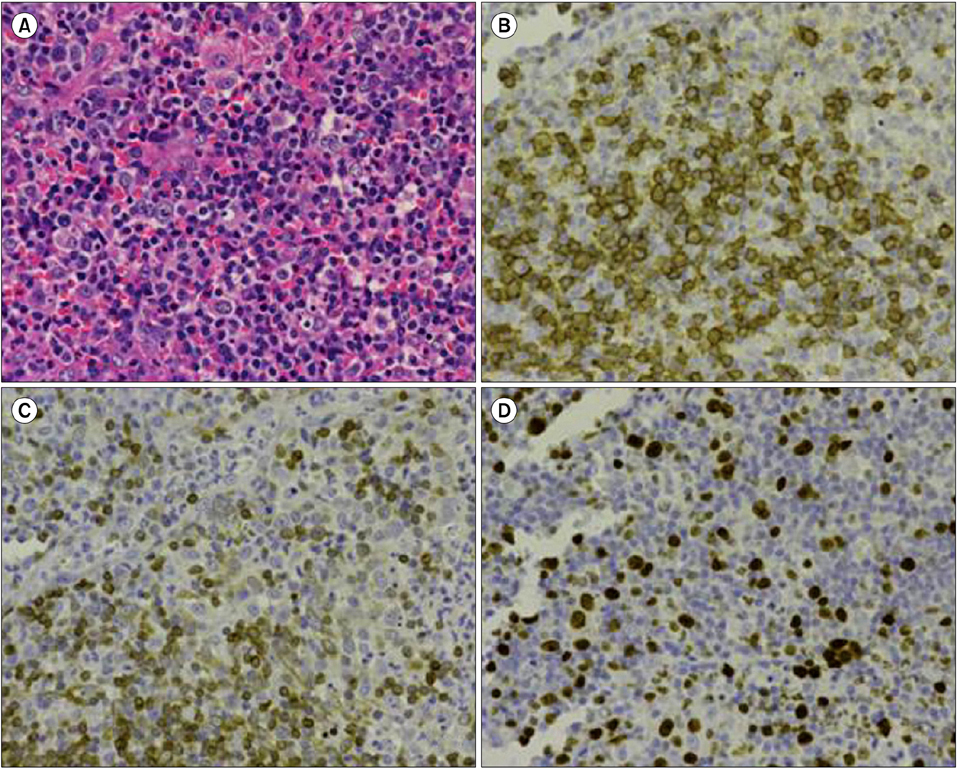Korean J Hematol.
2012 Dec;47(4):293-297. 10.5045/kjh.2012.47.4.293.
Successful treatment of diffuse large B-cell lymphoma with clarithromycin and prednisolone
- Affiliations
-
- 1Department of General Medicine, Hokkaido Social Insurance Hospital, Sapporo, Japan. masshi@isis.ocn.ne.jp
- 2Department of Pathology, Hokkaido Social Insurance Hospital, Sapporo, Japan.
- 3Hokkaido University Graduate School of Medicine, Sapporo, Japan.
- KMID: 1832109
- DOI: http://doi.org/10.5045/kjh.2012.47.4.293
Abstract
- We report a case of diffuse large B-cell lymphoma (DLBCL) treated successfully with clarithromycin (CAM) and prednisolone (PSL). A 71-year-old woman presented with fever and cervical pain. DLBCL was diagnosed based on histological results from lymph node biopsy. Cervical pain was thought to be caused by the invasion of lymphoma cells into the cervical vertebrae. She initially received radiotherapy for the cervical lesion. She did not receive conventional chemotherapy because of the risk of recurrent non-tuberculous mycobacteria infection; therefore, she was treated with 20 mg/day PSL and 800 mg/day CAM to induce apoptosis in lymphoma cells. Complete remission was achieved after 6 months. The present findings suggest that CAM and PSL may be effective in some cases of DLBCL.
MeSH Terms
Figure
Cited by 2 articles
-
A case of Waldenström's macroglobulinemia treated using clarithromycin and prednisolone
Masashi Ohe, Satoshi Hashino, Haruki Shida, Tetsuya Horita, Mitsuru Sugiura
Transl Clin Pharmacol. 2017;25(3):134-137. doi: 10.12793/tcp.2017.25.3.134.Successful treatment of angioimmunoblastic T-cell lymphoma with clarithromycin
Masashi Ohe, Satoshi Hashino
Blood Res. 2016;51(2):139-142. doi: 10.5045/br.2016.51.2.139.
Reference
-
1. Govi S, Dognini GP, Licata G, et al. Six-month oral clarithromycin regimen is safe and active in extranodal marginal zone B-cell lymphomas: final results of a single-centre phase II trial. Br J Haematol. 2010. 150:226–229.
Article2. Ishimatsu Y, Mukae H, Matsumoto K, et al. Two cases with pulmonary mucosa-associated lymphoid tissue lymphoma successfully treated with clarithromycin. Chest. 2010. 138:730–733.
Article3. Ohe M, Hashino S. A case of follicular B-cell lymphoma treated using clarithromycin. Korean J Hematol. 2011. 46:203–206.
Article4. Niesvizky R, Jayabalan DS, Christos PJ, et al. BiRD (Biaxin [clarithromycin]/Revlimid [lenalidomide]/dexamethasone) combination therapy results in high complete- and overall-response rates in treatment-naive symptomatic multiple myeloma. Blood. 2008. 111:1101–1109.
Article5. The International Non-Hodgkin's Lymphoma Prognostic Factors Project. A predictive model for aggressive non-Hodgkin's lymphoma. N Engl J Med. 1993. 329:987–994.6. Matsumoto A, Enomoto T, Muroya Y, et al. Pulmonary non-tuberculous mycobacteriosis (Mycobacterium intracellulare) with cavities developing in a non-small cell lung cancer patient during chemotherapy. Nihon Kokyuki Gakkai Zasshi. 2010. 48:609–613.7. Pavlidis NA, Manoussakis MN, Germanidis GS, et al. Serum soluble interleukin-2 receptors in B-cell lymphoproliferative malignancies. Med Pediatr Oncol. 1992. 20:26–31.
Article8. Ohara T, Morishita T, Suzuki H, Masaoka T, Ishii H, Hibi T. Antibiotics directly induce apoptosis in B cell lymphoma cells derived from BALB/c mice. Anticancer Res. 2004. 24:3723–3730.9. Chen Y, Han T, Iqbal J, et al. Diffuse large B-cell lymphoma in Chinese patients: immunophenotypic and cytogenetic analyses of 124 cases. Am J Clin Pathol. 2010. 133:305–313.10. Iqbal J, Neppalli VT, Wright G, et al. BCL2 expression is a prognostic marker for the activated B-cell-like type of diffuse large B-cell lymphoma. J Clin Oncol. 2006. 24:961–968.
Article11. Heckman CA, Mehew JW, Boxer LM. NF-kappaB activates Bcl-2 expression in t(14;18) lymphoma cells. Oncogene. 2002. 21:3898–3908.
Article12. Bavi P, Uddin S, Bu R, et al. The biological and clinical impact of inhibition of NF-κB-initiated apoptosis in diffuse large B cell lymphoma (DLBCL). J Pathol. 2011. 224:355–366.
Article13. Ichiyama T, Nishikawa M, Yoshitomi T, et al. Clarithromycin inhibits NF-kappaB activation in human peripheral blood mononuclear cells and pulmonary epithelial cells. Antimicrob Agents Chemother. 2001. 45:44–47.
Article14. Ploner C, Schmidt S, Presul E, et al. Glucocorticoid-induced apoptosis and glucocorticoid resistance in acute lymphoblastic leukemia. J Steroid Biochem Mol Biol. 2005. 93:153–160.
Article15. Weller M. Glucocorticoid treatment of primary CNS lymphoma. J Neurooncol. 1999. 43:237–239.
- Full Text Links
- Actions
-
Cited
- CITED
-
- Close
- Share
- Similar articles
-
- Successful treatment of recurrent follicular B-cell lymphoma with clarithromycin, prednisolone, and cyclophosphamide
- Successful Treatment of Polymyalgia Rheumatica with Prednisolone in Combination with Clarithromycin and Tacrolimus
- Successful treatment of angioimmunoblastic T-cell lymphoma with clarithromycin
- Treatment of Diffuse Large B Cell Lymphoma
- Glucocorticoid Triggers an Attack of Periodic Hypokalemic Paralysis during Treatment for Diffuse Large B-cell Lymphoma





